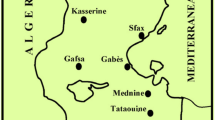Abstract
The thermal shock resistance of a kaolinite-based refractory prepared with a binder derived from a plant (corchorus olitorius) was investigated. Thermal shock tests employing water-quenching technique were performed at quench temperature differences of between 80 and 580 °C and then the damage parameter, and thermal shock parameters (R, R′, and R′′′) evaluated using measured strength and modulus values. The results showed that R and R′ parameters increased with increasing binder concentrations, an indication that the damage due to crack initiation was progressively impaired with increased binder concentrations. The R′′′ parameter on the other hand decreased with increasing binder concentrations indicating poor resistance of the material to crack propagation. These observations were also matched with thermal shock results which showed that samples plasticized with higher binder concentration had relatively very high strengths before thermal shock, compared to those plasticized with plain water, but they experienced rather large strength losses (over 60% of their initial values) at quench temperature difference (ΔT) exceeding 325 °C. The critical temperature difference (ΔT C) for the samples tested was in the range 250–325 °C. Scanning electron microscope (SEM) micrographs of samples quenched at temperature difference of 580 °C showed that samples plasticized with high binder concentration (0.68) experienced severe cracking of the matrix compared to their counterparts plasticized with plain water, whose microstructures showed an inhibited crack propagation.








Similar content being viewed by others
References
Papargyris AD, Cooke RD (1996) Brit Ceram Trans 95(3):107
Becher P (1981) J Am Ceram Soc 64(1):37
Bayuseno P, Athanasius L, Bruno A, O’Connor HOB (1999) J Am Ceram Soc 82(4):819
Brewer JA, Moore RH, Reed JS (1981) Am Ceram Soc Bull 68(2):212
Tanaka H, Fukai S, Uchida N, Uematsu K, Sakamoto A, Nagao Y (1994) J Am Ceram Soc 77(12):3077
Baklouti S, Chartier T, Baumard JF (1997) J Am Ceram Soc 80(8):1992
Aduda BO, Nyongesa FW, Obado G (1999) J Mater Sci Lett 18:1653
Park S and Hartley JG (1999) J Appl Phys 86(9):5263
Liwu W, Aldinger F (2000) Adv Eng Mater 2(3):109
Ogacho AA, Aduda BO, Nyongesa FW (2003) J Mater Sci 38:2293
Aksel C, Warren PD (2003) J Euro Ceram Soc 23:301
Kelly A, Macmillan NH (1986) Strong Solids, 3rd ed. Clarendon Press, New York pp. 55-95, 179–186
Hasselman DPH (1963) J Am Soc 46(11):535
Hasselman DPH (1969) J Am Soc 52(11):600
Hasselman DPH (1970) Am Cerm Soc Bull 49(12):1033
Kulkarni N, Moudgil B, Bhardwaj M (1994) Am Ceram Soc Bull 73(6):146
Nyongesa FW, Aduda BO (2000) Brit Ceram Trans 99(5):206
Ogacho AA (2002) MSc. Thesis, University of Nairobi, Kenya
Vedula RV, Green DJ, Hellman JR (1999) J Am Ceram Soc 82(3):649
Zhang J, Perez RJ, Wong CR, Lavernia EJ (1994) Mater Sci Eng R13:325–390
Bruck AH, Barry HR (1999) Am Ceram Soc 82:2927
Kaye GWC, Laby TH (1986) Tables of physical and chemical constants and some mathematical functions 5th edn. Longmans, London
Kingery WD, Bowen HK, Uhlmann DR (1991) Introduction to Ceramics, 2nd edn. John Wiley & Sons, Singapore, p 829
Acknowledgements
The authors wish to thank the International programme in Physical Sciences (IPPS) of Uppsala University Sweden for partial funding of the project, and the University of Nairobi for providing scholarship to AAO, and research facilities.
Author information
Authors and Affiliations
Corresponding author
Rights and permissions
About this article
Cite this article
Ogacho, A.A., Aduda, B.O. & Nyongesa, F.W. Thermal shock behaviour of a kaolinte refractory prepared using a natural organic binder. J Mater Sci 41, 8276–8283 (2006). https://doi.org/10.1007/s10853-006-1007-6
Received:
Accepted:
Published:
Issue Date:
DOI: https://doi.org/10.1007/s10853-006-1007-6




